Visa Bundle
How Does the Visa Company Power Global Commerce?
Visa, a global titan in digital payments, is the unseen force behind countless transactions worldwide. While not a direct issuer of Visa SWOT Analysis, it's a critical player in the financial services landscape, connecting billions of consumers, millions of merchants, and thousands of financial institutions. Understanding how Visa works is paramount for anyone looking to navigate the complexities of modern finance.
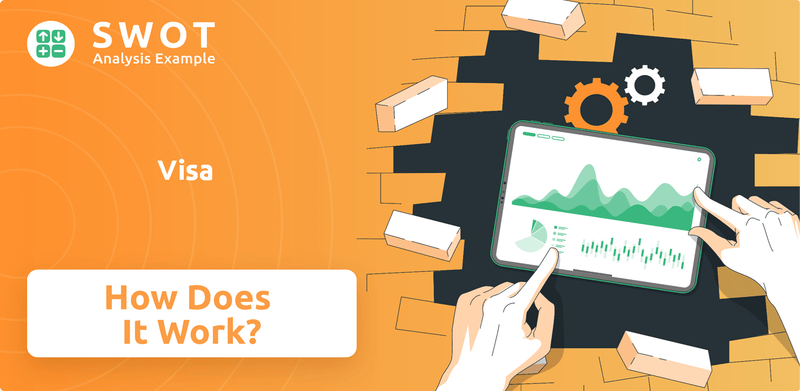
Visa's recent financial performance highlights its continued dominance in the payment processing sector. With its vast global network and commitment to innovation, Visa facilitates seamless transactions, impacting everything from Visa SWOT Analysis and credit cards to international payments and e-commerce. This exploration will delve into Visa's revenue model, its relationship with banks, and the technological prowess that underpins its success, providing valuable insights for investors and industry watchers alike.
What Are the Key Operations Driving Visa’s Success?
The core value proposition of the Visa company revolves around providing a secure, reliable, and efficient global payments network. It acts as the technological backbone for transactions, connecting cardholders, merchants, and financial institutions. Unlike traditional banks, Visa doesn't issue cards or extend credit; instead, it facilitates the movement of money.
The company's primary offerings include branded payment credentials like Visa, Visa Debit, and Visa Electron, accepted worldwide. Its operational processes are centered on VisaNet, a proprietary global processing network that handles billions of transactions annually. This platform provides authorization, clearing, and settlement services, ensuring swift and secure transactions.
When a consumer uses a Visa card, VisaNet routes the transaction data between the merchant’s bank (acquirer) and the cardholder’s bank (issuer). This intricate process incorporates robust fraud detection tools and advanced security protocols to protect sensitive financial information, ensuring rapid approval or denial. The company's commitment to security and efficiency translates directly into customer benefits, offering convenience, broad acceptance, and peace of mind for both consumers and businesses. Learn more about the Growth Strategy of Visa.
Visa boasts an extensive global reach, with its network connecting over 3.3 billion cards in circulation worldwide as of the first quarter of fiscal year 2025. This widespread acceptance highlights its significant impact on international payments. The company's presence spans across numerous countries, making it a key player in the financial services sector.
The network effect is a crucial aspect of Visa's operations. Partnerships with financial institutions, technology providers, and merchants form a vast ecosystem. As more participants join this network, the value of Visa's services increases, benefiting both consumers and businesses. This expansive network drives innovation and enhances the overall payment experience.
Visa prioritizes security and efficiency in its operations. Its advanced fraud detection tools and security protocols protect sensitive financial information during transactions. This commitment ensures that transactions are processed quickly and securely, providing peace of mind for both consumers and merchants. The company continually invests in technologies to enhance these aspects.
The operational strengths of Visa translate directly into significant benefits for customers. Consumers enjoy the convenience of broad acceptance and secure transactions, while businesses benefit from efficient payment processing and reduced risk. Visa's services support both online and in-store transactions, making it a versatile payment solution.
Visa's operational model is distinguished by its global reach, advanced technology, and commitment to security. This approach ensures seamless and reliable payment processing for billions of transactions annually. Its focus on innovation and customer service further enhances its value proposition.
- Global Payment Network: Visa operates a vast global network that connects millions of merchants and financial institutions.
- Transaction Processing: VisaNet processes billions of transactions, ensuring speed and security.
- Security Measures: Advanced fraud detection and security protocols protect sensitive financial data.
- Customer Benefits: Convenience, broad acceptance, and peace of mind for both consumers and businesses.
Visa SWOT Analysis
- Complete SWOT Breakdown
- Fully Customizable
- Editable in Excel & Word
- Professional Formatting
- Investor-Ready Format
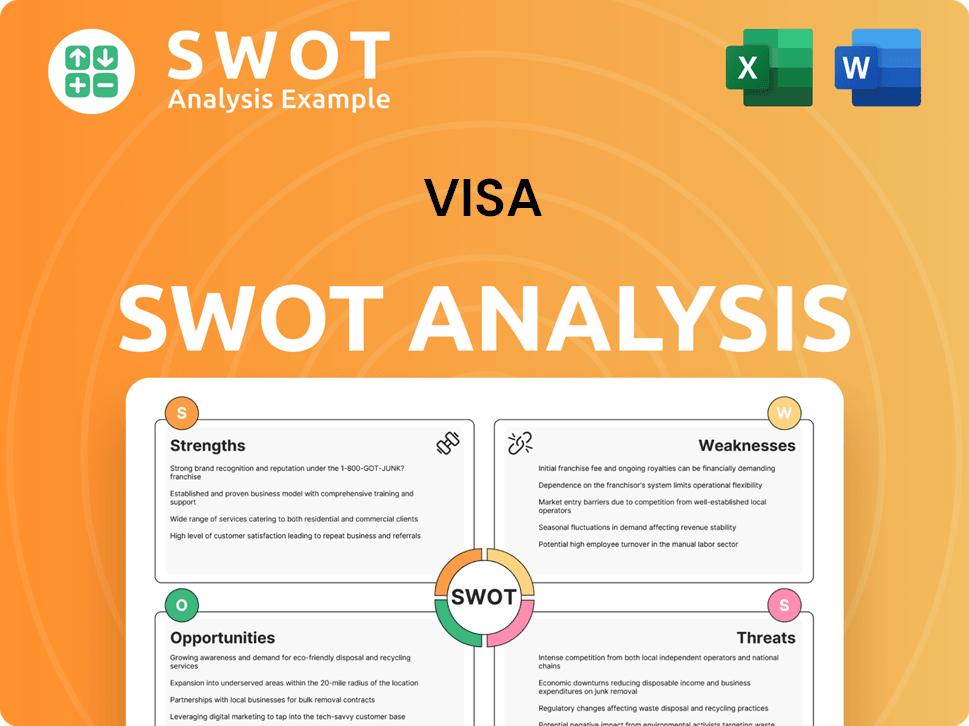
How Does Visa Make Money?
The Visa company generates revenue through several key streams, primarily centered around payment processing and financial services. These revenue streams are diversified to capture value from various aspects of the payment ecosystem. The company's financial performance is closely tied to the volume and value of transactions processed across its global network.
Understanding how Visa works involves examining its monetization strategies, which are designed to leverage its extensive network and brand recognition. The company's revenue model is built on a foundation of transaction fees, data processing charges, and international transaction fees. These fees are influenced by factors such as transaction volume, the types of transactions, and the geographic locations where the transactions occur.
The company's operations are supported by a robust infrastructure that facilitates secure and efficient payment processing. This infrastructure is crucial for its ability to generate revenue and maintain its position in the competitive landscape of financial services. To learn more about the company's target market, you can read this article: Target Market of Visa.
Service revenues are a significant portion of the company's income, recognized based on payment volume. For the first quarter of fiscal year 2025, service revenues increased by 7% over the prior year.
Data processing revenues come from the authorization, clearing, and settlement of transactions. In the first quarter of fiscal year 2025, data processing revenues grew by 8% year-over-year.
International transaction revenues are generated from cross-border payments. These revenues are influenced by the volume of cross-border transactions and currency exchange rates.
Other revenues include value-added services like risk management, consulting, and loyalty program management. These services contribute to the company's diverse revenue streams.
The company uses tiered pricing models based on transaction volume and service levels. This approach incentivizes larger financial institutions and merchants to use its network more.
The company continuously explores new revenue opportunities through strategic partnerships and the development of innovative payment solutions, such as those related to B2B payments and new payment flows.
The company's revenue model is multifaceted, encompassing various streams to maximize profitability. Understanding these strategies provides insight into the company's financial performance and market position.
- Service Revenues: Driven by payment volume, contributing significantly to overall income. In the first quarter of fiscal year 2025, these revenues reached $3.9 billion.
- Data Processing Revenues: Generated from transaction authorization, clearing, and settlement. Data processing revenues totaled $4.3 billion in the first quarter of fiscal year 2025.
- International Transaction Revenues: Derived from cross-border payments, affected by transaction volume and currency exchange rates.
- Other Revenues: Include value-added services like risk management and consulting.
- Tiered Pricing: Pricing models based on transaction volume and service levels.
- Strategic Partnerships: Focus on developing innovative payment solutions, including B2B payments.
Visa PESTLE Analysis
- Covers All 6 PESTLE Categories
- No Research Needed – Save Hours of Work
- Built by Experts, Trusted by Consultants
- Instant Download, Ready to Use
- 100% Editable, Fully Customizable
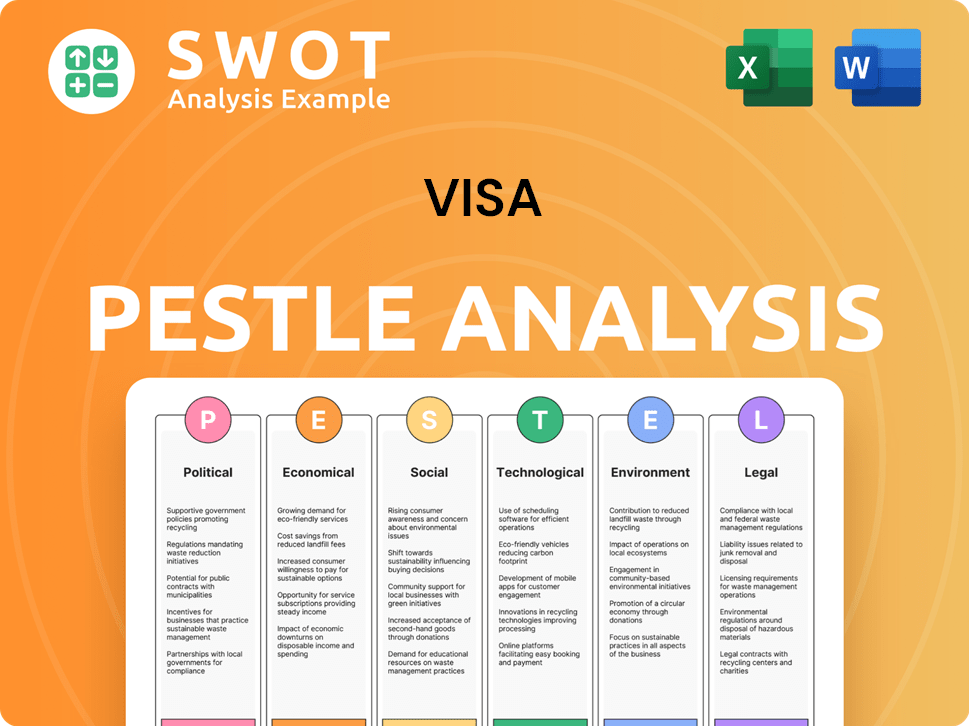
Which Strategic Decisions Have Shaped Visa’s Business Model?
The story of the Visa company is one of remarkable growth and strategic adaptation, evolving from a credit card pioneer to a global leader in digital payments. Its journey has been marked by key milestones, strategic moves, and a relentless focus on maintaining its competitive edge in the fast-paced financial services industry. From its early days to its current status, Visa has consistently demonstrated its ability to innovate and respond to the changing needs of consumers and merchants worldwide.
A core element of Visa's strategy has been continuous investment in technology and infrastructure. This includes enhancing its VisaNet processing capabilities to handle massive transaction volumes and integrating advanced security features. Furthermore, the company has strategically expanded its global footprint, building partnerships in emerging markets and extending its reach to increase payment volumes across the globe. These efforts have solidified its position as a dominant force in the payment processing landscape.
Operational challenges, such as adapting to evolving regulatory landscapes and combating cyber threats, are addressed through robust compliance programs and continuous cybersecurity enhancements. Visa's proactive approach to tokenization and fraud prevention technologies helps mitigate risks and maintain trust in its network. The company’s competitive edge is multifaceted, resting on its powerful brand recognition, the unparalleled scale of its global network, and its technological leadership.
Key milestones include the launch of its first credit card, the development of its global payment network, and its initial public offering (IPO). These events have shaped its trajectory and established its presence in the financial services sector. The IPO, in particular, provided the capital for further expansion and technological advancements.
Strategic moves include acquisitions to expand its service offerings, such as the purchase of companies specializing in fraud prevention and digital payments. Visa has also formed partnerships with fintech firms to integrate new technologies into its network. Furthermore, it has invested heavily in mobile payment solutions and contactless technology to meet evolving consumer preferences.
Visa's competitive edge is built on its global network, brand recognition, and technological prowess. The network effect, where the value increases with each new participant, creates a formidable barrier to entry. Strong relationships with financial institutions and merchants globally provide a significant advantage. Visa continues to adapt to new trends by investing in areas like B2B payments, open banking, and real-time payments.
Technological advancements include the development of advanced fraud detection systems, tokenization services, and secure payment gateways. These innovations enhance the security and efficiency of transactions. Visa's commitment to innovation ensures it remains at the forefront of the payment processing industry, meeting the evolving needs of consumers and merchants.
In fiscal year 2024, Visa reported a net revenue of approximately $32.6 billion, demonstrating its strong financial performance. The company processed over 250 billion transactions, highlighting the scale of its global network. Visa's commitment to innovation is reflected in its investments in technology, with over $3.5 billion allocated to research and development in 2024.
- Visa's global network connects over 80 million merchants and over 4.5 billion cards.
- The company's market capitalization is consistently among the highest in the financial services sector, reflecting its strong position.
- Visa's fraud detection systems prevented approximately $26 billion in fraud losses in 2024.
- Visa's expansion into emerging markets continues, with significant growth in regions like Asia-Pacific and Latin America.
Visa Business Model Canvas
- Complete 9-Block Business Model Canvas
- Effortlessly Communicate Your Business Strategy
- Investor-Ready BMC Format
- 100% Editable and Customizable
- Clear and Structured Layout
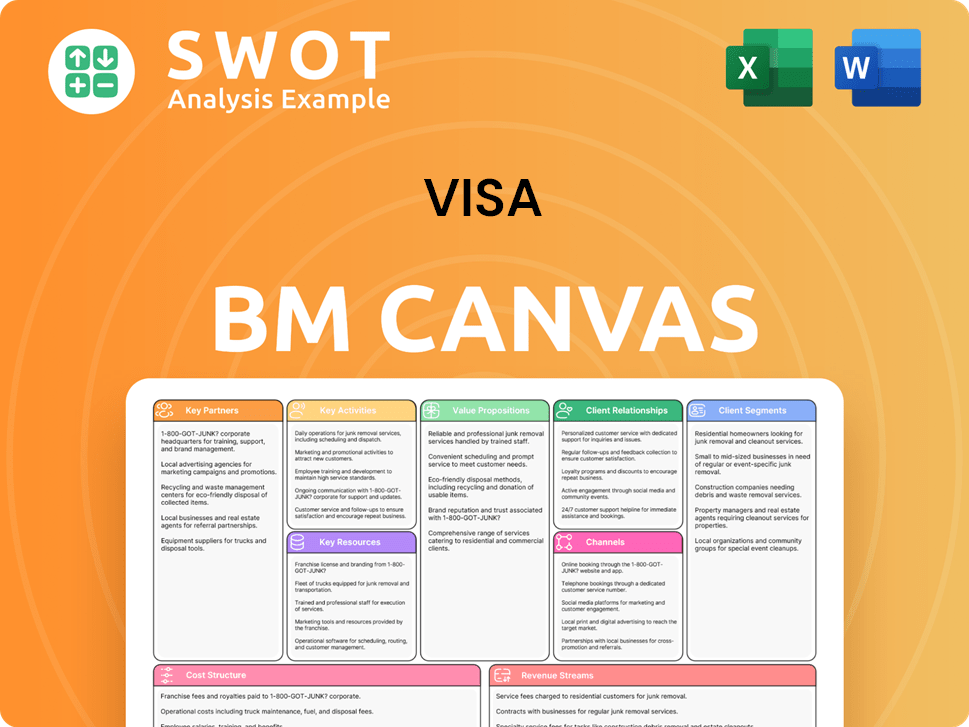
How Is Visa Positioning Itself for Continued Success?
The Visa company holds a leading position in the global payments industry, competing closely with Mastercard for market share in card payments. Its robust network and widespread acceptance provide a significant competitive edge, fostering strong customer loyalty among financial institutions and merchants worldwide. The company's global reach is extensive, with its payment products accepted in over 200 countries and territories.
Despite its strong market position, Visa faces several risks, including regulatory changes impacting interchange fees and data privacy across different jurisdictions. The emergence of new payment technologies and competition from fintech startups also pose challenges. However, the company is actively pursuing strategic initiatives to sustain and expand its monetization capabilities.
Visa is a global leader in payment processing, with a vast network and strong brand recognition. It competes directly with Mastercard, holding a substantial share of the credit card and debit card markets. Its widespread acceptance and strong relationships with financial institutions give it a significant advantage.
Key risks include regulatory changes affecting interchange fees and data privacy. Competition from fintech companies and the rise of new payment technologies, such as blockchain solutions, also pose challenges. Cybersecurity threats and economic downturns can further impact the company's performance.
Visa is focused on diversifying its revenue streams beyond traditional credit and debit transactions. The company is expanding into new payment flows, including B2B payments and government disbursements. Investments in value-added services like fraud prevention and data analytics are also key.
Visa is investing in artificial intelligence, open banking, and cross-border payments to facilitate the future of money movement. The company aims to adapt to changing consumer preferences and technological advancements. Expanding its global network and partnerships is a priority.
Visa is focused on expanding its global network and diversifying its revenue streams. The company is investing in innovative technologies and partnerships to enhance its services. They are also focused on improving security and customer experience.
- Expand into B2B payments and government disbursements.
- Invest in AI, open banking, and cross-border payment solutions.
- Enhance fraud prevention and data analytics services.
- Strengthen relationships with financial institutions and merchants.
Visa Porter's Five Forces Analysis
- Covers All 5 Competitive Forces in Detail
- Structured for Consultants, Students, and Founders
- 100% Editable in Microsoft Word & Excel
- Instant Digital Download – Use Immediately
- Compatible with Mac & PC – Fully Unlocked
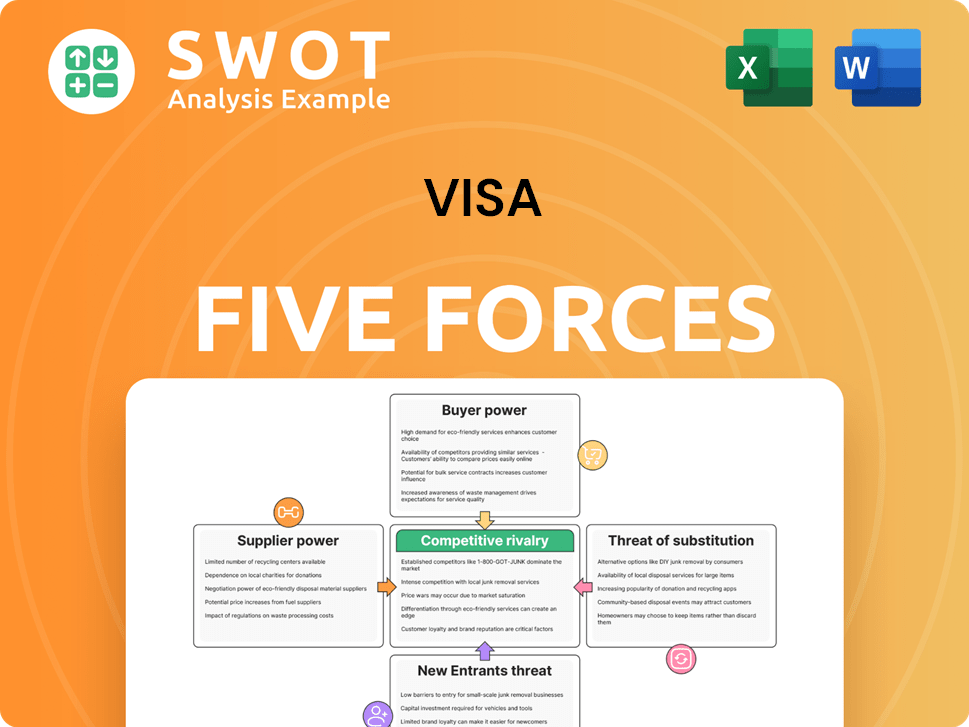
Related Blogs
- What are Mission Vision & Core Values of Visa Company?
- What is Competitive Landscape of Visa Company?
- What is Growth Strategy and Future Prospects of Visa Company?
- What is Sales and Marketing Strategy of Visa Company?
- What is Brief History of Visa Company?
- Who Owns Visa Company?
- What is Customer Demographics and Target Market of Visa Company?
Disclaimer
All information, articles, and product details provided on this website are for general informational and educational purposes only. We do not claim any ownership over, nor do we intend to infringe upon, any trademarks, copyrights, logos, brand names, or other intellectual property mentioned or depicted on this site. Such intellectual property remains the property of its respective owners, and any references here are made solely for identification or informational purposes, without implying any affiliation, endorsement, or partnership.
We make no representations or warranties, express or implied, regarding the accuracy, completeness, or suitability of any content or products presented. Nothing on this website should be construed as legal, tax, investment, financial, medical, or other professional advice. In addition, no part of this site—including articles or product references—constitutes a solicitation, recommendation, endorsement, advertisement, or offer to buy or sell any securities, franchises, or other financial instruments, particularly in jurisdictions where such activity would be unlawful.
All content is of a general nature and may not address the specific circumstances of any individual or entity. It is not a substitute for professional advice or services. Any actions you take based on the information provided here are strictly at your own risk. You accept full responsibility for any decisions or outcomes arising from your use of this website and agree to release us from any liability in connection with your use of, or reliance upon, the content or products found herein.